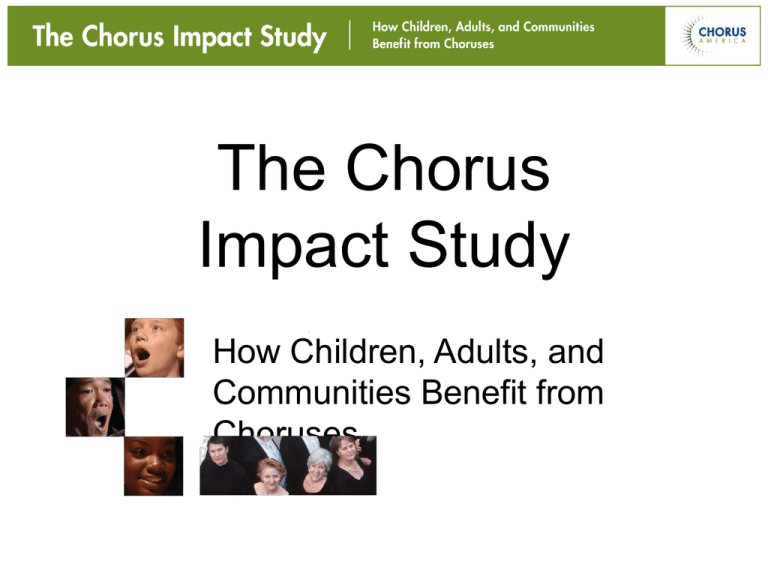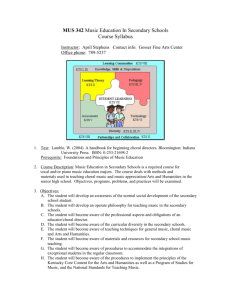PowerPoint Slides: Summary of Impact Study
advertisement

The Chorus Impact Study How Children, Adults, and Communities Benefit from Choruses Project Goals • Track trends since Chorus America’s 2003 research and learn more about the attributes of choral singers. • Explore the value of choral singing for children and youth. Methodology • Respected research firm • Online surveys of: – More than 2,000 singers in choruses of all kinds – 500 members of the general public – 500 parents – 300 K-12 educators from a variety of disciplines • Audiences and choral singers alike have long understood the intrinsic value of choral music. • New data shows that choruses generate additional benefits, and advance positive qualities that are associated with success in life both for children and adults. Four primary findings 1. Far more people sing in choruses than participate in any other performing art. 2. People who sing in choruses demonstrate characteristics that make them remarkably good citizens. 3. Children who sing in choruses have academic success and valuable life skills. 4. There is a troubling decline in choral singing opportunities for children. Finding 1 • 42.6 million people sing in more than 270,000 choruses today. • That’s far more than participate in any other performing art. • These numbers are up since Chorus America’s research in 2003. More than any other performing art… Choruses perform music that provides a means of expressing something greater than each individual participant. More than any other performing art… • A thriving and growing form of artistic expression, and in addition to providing great musical performances, advances many of the positive qualities associated with success both for children and adults. Finding 2 People who sing in choruses demonstrate characteristics that make them remarkably good citizens. Good citizens… • Choral singers are far more likely to: – Volunteer in their communities – Contribute money to philanthropic causes – Take on leadership roles – Be team members – Participate in the political process Good citizens… 61 % of adult choral singers read newspapers daily (compared to 48% of the general public). Good citizens… 87 % of adult choral singers have read a book in the last month (compared to 59% of the general public). Good citizens… 96 % of adult choral singers vote in national and local elections (compared to 70% of the general public). Good citizens… Chart 2: Civic Engagement, Chorus Members vs. General Public Chart 3: Civic Engagement, Chorus Members vs. General Public Finding 3 • Children who sing in choruses have academic success and valuable life skills. • Parents and educators from every discipline attribute a significant part of academic success to singing in a choir. Benefits for children who sing… 70% of parents said their child • is more self-confident • is more self-disciplined • developed better memory skills Chart 5: Choir Participation and Children’s Success Skills Benefits for children who sing… 80% of educators and parents say that choir participation enhances numerous aspects of a child’s: • academic success (including better grades) • social development Chart 4: Choir Participation and Academic Performance Benefits for children who sing… 90% of educators believe choir participation keeps some students engaged in school who might otherwise be lost. Chart 6: Educators on Choir Participation and Student Success Skills Chart 7: Educators on Student Choir Participation and Social Skills Chart 8: Choir Participation and School, Community Participation Benefits for children who sing… • Previous research on value of instrumental music education. • Choral singing has often been overlooked by researchers—this data fills that research gap. The “chorus effect” • Parents date their child’s improvements in a variety of areas to their joining a choral group. • That, and the breadth of benefits described by both parents and educators, points to a unique ‘chorus effect,’ one that isn’t simply replicated by participation in other activities. Finding 4 • There is a troubling decline in chorus opportunities for children. • An alarming trend suggests that these opportunities are not available, being reduced, or eliminated from schools across the country. Decline in choral singing opportunities for children… • More than one in four educators surveyed said there is no choral program in their schools. • More than one in five parents said that there were no choral singing opportunities for their children in their communities • Nearly 20% of parents whose children have never sung in a choir say they would be extremely or very interested in signing their child up, illustrating a “chorus gap” Making the case for choral programs • Choral singing is an accessible entry point for arts exposure, with fewer barriers—economic, cultural, or educational. • More choral singing opportunities in schools and communities could be a good strategy for bolstering student achievement and engagement in schools. • Leveraging the benefits that choruses bring to children, adults, and communities is good for schools and society. Wrap Up Chorus America’s 2009 Chorus Impact Study • Choruses enrich the cultural and civic life of our communities. • Enhance the lives of choral singers. • For more information about how to use these resources, visit www.chorusamerica.org.











